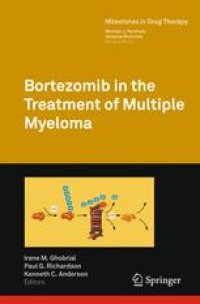
Ebook: Bortezomib in the Treatment of Multiple Myeloma
- Tags: Oncology, Cancer Research, Pharmacology/Toxicology, Apoptosis
- Series: Milestones in Drug Therapy
- Year: 2011
- Publisher: Springer Basel
- Edition: 1
- Language: English
- pdf
Multiple Myeloma (MM) is the second most common type of blood cancer, resulting from an overproduction of cancerous infection-fighting white blood cells, known as plasma cells. Plasma cells are a crucial part of the immune system responsible for the production of antibodies. Bortezomib is a promising anticancer drug targeting the proteasome. This proteasome inhibitor induces cell stress and apoptosis in the cancer cells. While multiple mechanisms are likely to be involved, proteasome inhibition may prevent the degradation of pro-apoptotic factors, permitting activation of programmed cell death in neoplastic cells dependent upon the suppression of proapoptotic pathways. This monograph on bortezomib is a valuable source of information for researchers and clinicians from the fields of oncology and pharmacology, working either in academia or the pharmaceutical industry.
Multiple Myeloma (MM) is the second most common type of blood cancer, resulting from an overproduction of cancerous infection-fighting white blood cells, known as plasma cells. Plasma cells are a crucial part of the immune system responsible for the production of antibodies. Bortezomib is a promising anticancer drug targeting the proteasome. This proteasome inhibitor induces cell stress and apoptosis in the cancer cells. While multiple mechanisms are likely to be involved, proteasome inhibition may prevent the degradation of pro-apoptotic factors, permitting activation of programmed cell death in neoplastic cells dependent upon the suppression of proapoptotic pathways. This monograph on bortezomib is a valuable source of information for researchers and clinicians from the fields of oncology and pharmacology, working either in academia or the pharmaceutical industry.
Multiple Myeloma (MM) is the second most common type of blood cancer, resulting from an overproduction of cancerous infection-fighting white blood cells, known as plasma cells. Plasma cells are a crucial part of the immune system responsible for the production of antibodies. Bortezomib is a promising anticancer drug targeting the proteasome. This proteasome inhibitor induces cell stress and apoptosis in the cancer cells. While multiple mechanisms are likely to be involved, proteasome inhibition may prevent the degradation of pro-apoptotic factors, permitting activation of programmed cell death in neoplastic cells dependent upon the suppression of proapoptotic pathways. This monograph on bortezomib is a valuable source of information for researchers and clinicians from the fields of oncology and pharmacology, working either in academia or the pharmaceutical industry.
Content:
Front Matter....Pages i-viii
Bortezomib’s Scientific Origins and Its Tortuous Path to the Clinic....Pages 1-27
Preclinical Activities of Bortezomib in MM, the Bone Marrow Microenvironment and Pharmacogenomics....Pages 29-42
Bortezomib and Osteoclasts and Osteoblasts....Pages 43-52
Bortezomib in the Upfront Treatment of Multiple Myeloma....Pages 53-68
The Use of Bortezomib in Autologous Transplantation for Multiple Myeloma....Pages 69-77
Bortezomib in Relapsed and Relapsed/Refractory Multiple Myeloma....Pages 79-94
Bortezomib-Induced Peripheral Neuropathy in Multiple Myeloma: Principles of Identification and Management....Pages 95-105
Bortezomib in Mantle Cell Lymphoma....Pages 107-121
Bortezomib in Waldenstrom’s Macroglobulinemia....Pages 123-133
Bortezomib in Systemic Light-Chain Amyloidosis....Pages 135-148
Second-Generation Proteasome Inhibitors....Pages 149-176
Back Matter....Pages 177-179
Multiple Myeloma (MM) is the second most common type of blood cancer, resulting from an overproduction of cancerous infection-fighting white blood cells, known as plasma cells. Plasma cells are a crucial part of the immune system responsible for the production of antibodies. Bortezomib is a promising anticancer drug targeting the proteasome. This proteasome inhibitor induces cell stress and apoptosis in the cancer cells. While multiple mechanisms are likely to be involved, proteasome inhibition may prevent the degradation of pro-apoptotic factors, permitting activation of programmed cell death in neoplastic cells dependent upon the suppression of proapoptotic pathways. This monograph on bortezomib is a valuable source of information for researchers and clinicians from the fields of oncology and pharmacology, working either in academia or the pharmaceutical industry.
Content:
Front Matter....Pages i-viii
Bortezomib’s Scientific Origins and Its Tortuous Path to the Clinic....Pages 1-27
Preclinical Activities of Bortezomib in MM, the Bone Marrow Microenvironment and Pharmacogenomics....Pages 29-42
Bortezomib and Osteoclasts and Osteoblasts....Pages 43-52
Bortezomib in the Upfront Treatment of Multiple Myeloma....Pages 53-68
The Use of Bortezomib in Autologous Transplantation for Multiple Myeloma....Pages 69-77
Bortezomib in Relapsed and Relapsed/Refractory Multiple Myeloma....Pages 79-94
Bortezomib-Induced Peripheral Neuropathy in Multiple Myeloma: Principles of Identification and Management....Pages 95-105
Bortezomib in Mantle Cell Lymphoma....Pages 107-121
Bortezomib in Waldenstrom’s Macroglobulinemia....Pages 123-133
Bortezomib in Systemic Light-Chain Amyloidosis....Pages 135-148
Second-Generation Proteasome Inhibitors....Pages 149-176
Back Matter....Pages 177-179
....